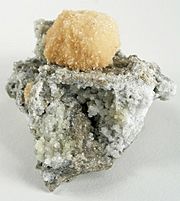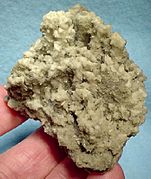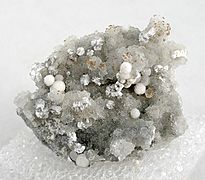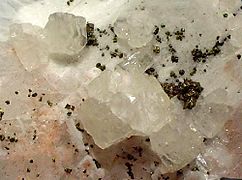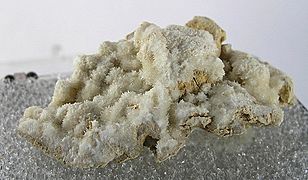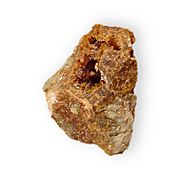Strontianite facts for kids
Quick facts for kids Strontianite |
|
|---|---|

Strontianite from Slovakia
|
|
| General | |
| Category | Carbonate minerals |
| Formula (repeating unit) |
SrCO3 |
| Strunz classification | 5.AB.15 (10 ed) 5/B.04-20 (8 ed) |
| Dana classification | 14.01.03.03 |
| Crystal symmetry | Pmcn |
| Unit cell | a = 5.1 Å, b = 8.4 Å c = 6.0 Å; Z = 4 |
| Identification | |
| Formula mass | 147.63 g/mol |
| Color | Colourless, white, gray, light yellow, green or brown; colourless in transmitted light |
| Crystal habit | Prismatic, acicular, pseudo hexagonal, columnar to fibrous, granular, massive |
| Crystal system | Orthorhombic |
| Twinning | Very common, usually contact, rarely penetration, also repeated |
| Cleavage | {110} nearly perfect, {021} poor, {010} traces |
| Fracture | Subconchoidal to uneven |
| Tenacity | Brittle |
| Mohs scale hardness | 3+1⁄2 |
| Lustre | Vitreous, resinous on breaks, greasy |
| Streak | White |
| Diaphaneity | Transparent to translucent |
| Specific gravity | 3.74 to 3.78 Transparent versions are heavier than the other ones |
| Optical properties | Biaxial(-) |
| Refractive index | nα = 1.52, nβ = 1.66, nγ = 1.67 |
| Birefringence | 0.15 |
| 2V angle | Measured: 7°, Calculated: 12° to 8° |
| Ultraviolet fluorescence | Almost always fluorescent |
| Solubility | Soluble in dilute HCl |
| Alters to | Celestine SrSO4 |
Strontianite is a special kind of mineral that helps us get the element strontium. Its chemical formula is SrCO3. It's quite rare to find, but it's one of the main sources of strontium.
Strontianite belongs to a group of minerals called the aragonite group. Other minerals in this group include aragonite (CaCO3), witherite (BaCO3), and cerussite (PbCO3).
Even though its ideal formula is SrCO3, strontianite can sometimes have other elements mixed in. For example, up to 27% of the strontium can be replaced by calcium (Ca). Also, a small amount of barium (Ba) can be found in it, up to 3.3%.
This mineral got its name in 1791 from a place called Strontian in Scotland. This is where the element strontium was first discovered just one year before. Strontium is actually quite common in the Earth's crust, much more common than copper! However, you'll never find pure strontium metal in nature. It's always combined with other elements.
The two most important minerals for getting strontium are celestine (SrSO4) and strontianite (SrCO3). To get strontium metal, people usually take strontium oxide and mix it with aluminium.
Contents
What is Strontianite's Crystal Structure?
Strontianite is an orthorhombic mineral. This means its crystals have three axes that are all different lengths and meet at 90-degree angles. It belongs to the most symmetrical group in this system.
The basic building block of its crystal, called the unit cell, has specific measurements. There are four chemical units (SrCO3) packed into each unit cell. The measurements for its sides are about a = 5.1 Å, b = 8.4 Å, and c = 6.0 Å.
How Strontianite's Structure is Built
Strontianite has a similar structure to aragonite. Imagine tiny triangular groups of carbon and oxygen (CO3). These groups are arranged in layers, almost like stacks of pancakes. Between these layers are layers of strontium atoms.
The CO3 groups are not perfectly flat; the carbon atom is slightly out of the plane of the oxygen atoms. These groups are also slightly tilted within the crystal structure.
How Strontianite Crystals Look
Strontianite crystals can grow in many different shapes. They often look like short prisms or thin, needle-like shapes called acicular crystals.
If the mineral has a lot of calcium, its crystals might look like steep pyramids. Sometimes, crystals can even look like hexagons, even though they are not truly hexagonal. The sides of the prism crystals often have horizontal lines on them.
Strontianite can also be found in other forms. It might appear as columns, fibers, or as grainy or rounded clumps.
What are Strontianite's Optical Properties?
Strontianite can be many colors: clear, white, gray, light yellow, green, or brown. When you look through a thin piece of it, it appears colorless. It can be transparent (you can see through it) or translucent (light passes through, but you can't see clearly).
It has a vitreous (glassy) shine, but if it breaks, the new surfaces might look resinous. When you rub it on a rough surface, it leaves a white streak.
Strontianite has special properties when light passes through it. It has different refractive indices depending on the direction the light travels. These values are around 1.52, 1.66, and 1.67. This difference in how light bends is called birefringence, and for strontianite, it's about 0.15.
Does Strontianite Glow?
Yes, strontianite almost always glows! It shines a bright yellowish-white color when exposed to ultraviolet light. This happens with shortwave, mediumwave, and longwave UV light.
If the glow continues even after the UV light is turned off, it's called phosphorescence. Most strontianite samples will phosphoresce with a strong, yellowish-white glow for a while after being exposed to UV light. It also glows when hit by X-rays and electron beams.
Sometimes, strontianite can also glow when heated, even at temperatures lower than red hot. This is called thermoluminescence.
What are Strontianite's Physical Properties?
Strontianite has a property called cleavage. This means it tends to break along flat surfaces. It breaks very cleanly along one set of prism faces. It also has weaker cleavage along other directions.
Twinning is very common in strontianite. This is when two or more crystals grow together in a mirrored or intergrown way. They can be contact twins (like reflections) or penetration twins (intergrown). Sometimes, strontianite forms repeated twins, where multiple crystals are twinned together in a pattern.
The mineral is brittle, meaning it breaks easily. When it breaks, the surface can be uneven or slightly curved, which is called a subconchoidal fracture.
Strontianite is quite soft. On the Mohs hardness scale, it has a hardness of 3.5. This means it's harder than calcite but softer than fluorite.
The specific gravity of pure strontianite is about 3.78. This number tells you how dense it is compared to water. If the strontianite has calcium mixed in, it will be slightly lighter, with a specific gravity between 3.74 and 3.78. If it has heavier elements like barium or lead, it will be denser.
Strontianite can dissolve in weak hydrochloric acid. It is also not radioactive.
Where is Strontianite Found?
Strontianite is an uncommon mineral that forms at low temperatures. It's often found in veins within rocks like limestone, marl, and chalk. You can also find it inside hollow, rounded rocks called geodes.
It's not very common in metal ore veins, but it is often found in special rocks called carbonatites. It probably forms at temperatures around 100°C (212°F). It usually grows in open spaces, suggesting it forms under low pressure, like the pressure of ground water.
Sometimes, strontianite can change into celestine (SrSO4), and celestine can also change into strontianite. These two minerals are often found together, along with baryte, calcite, and sulfur.
Famous Locations for Strontianite
The very first place strontianite was found and named after is Strontian, in Scotland, UK. Here, it was found in veins within a type of rock called gneiss.
Other places in the UK where it's found include the Brownley Hill Mine in England.
Strontianite in Canada
The Francon quarry in Montréal, Québec, Canada, is famous for its strontianite. It's found in many different shapes there. It can be clear to opaque, white to pale yellow or beige. It forms smooth spheres, half-spheres, and round clumps up to 10 cm across. Sometimes, it forms spheres made of many needle-like crystals radiating outwards. It can also be found as tufts, bundles, or fibrous clusters.
Another Canadian location is Nepean, Ontario, where it's found in veins in limestone.
Strontianite in Germany
Important deposits of strontianite are found in marls in Westphalia, Germany. It's also found with zeolites at Oberschaffhausen.
Strontianite in India
In Trichy, India, strontianite is found with celestine, gypsum, and phosphate nodules in clay.
Strontianite in Mexico
In the Sierra Mojada District, Mexico, strontianite is found with celestine in a lead-silver deposit.
Strontianite in Russia
Strontianite is found in the Kirovskii apatite mine in the Khibiny Massif, Russia. It's found in special rock cavities with other minerals like kukharenkoite-(La) and pyrite.
It's also found at Yukspor Mountain in the Khibiny Massif, in veins with minerals like aegirine and natrolite.
Strontianite in the United States
Along the Gulf coast of Louisiana and Texas, strontianite is found with celestine in the calcite "cap rock" of salt domes.
At the Minerva Number 1 Mine in Cave-in-Rock, Illinois, strontianite appears as white, brown, or sometimes pink tufts and bowties of needle-like crystals.
In Lockport, New York, strontianite is seen in cavities in limestone, forming small white sprays of needle-like crystals.
In Schoharie County, New York, it's found in geodes and veins with celestine and calcite in limestone. In Mifflin County, Pennsylvania, it's found with aragonite in limestone.
Images for kids
See also
- Strontian process


